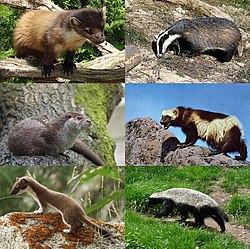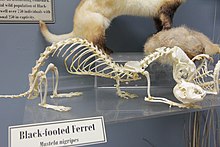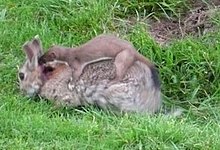Mustelidae
| Mustelidae Temporal range: [1]
| |
|---|---|
 | |
| Scientific classification | |
| Domain: | Eukaryota |
| Kingdom: | Animalia |
| Phylum: | Chordata |
| Class: | Mammalia |
| Order: | Carnivora |
| Superfamily: | Musteloidea |
| Family: | Mustelidae G. Fischer de Waldheim , 1817
|
| Type genus | |
| Mustela Linnaeus, 1758
| |
| Subfamilies | |
| |

| |
| The native distribution and density of extant Mustelid species. | |
The Mustelidae (
Variety
This article needs additional citations for verification. (March 2022) |

Mustelids vary greatly in size and behaviour. The smaller variants of the
Being one of the most species-rich families in the order Carnivora, the family Mustelidae also is one of the oldest. Mustelid-like forms first appeared about 40 million years ago (Mya), roughly coinciding with the appearance of rodents. The common ancestor of modern mustelids appeared about 18 Mya.[4]
Characteristics

Within a large range of variation, the mustelids exhibit some common characteristics. They are typically small animals with elongated bodies, short legs, short skulls, short, round ears, and thick fur.[5] Most mustelids are solitary, nocturnal animals, and are active year-round.[6]
With the exception of the sea otter
Most mustelid reproduction involves
Mustelids are predominantly carnivorous, although some eat vegetable matter at times. While not all mustelids share an identical
Ecology

The fisher, tayra, and martens are partially arboreal, while badgers are fossorial. A number of mustelids have aquatic lifestyles, ranging from semiaquatic minks and river otters to the fully aquatic sea otter, which is one of the few nonprimate mammals known to use tools while foraging. It uses "anvil" stones to crack open the shellfish that form a significant part of its diet. It is a "keystone species", keeping its prey populations in balance so some do not outcompete the others and destroy the kelp in which they live.
The black-footed ferret is entirely dependent on another keystone species, the prairie dog. A family of four ferrets eats 250 prairie dogs in a year; this requires a stable population of prairie dogs from an area of some 500 acres (2.0 km2).
Animals of similar appearance
Skunks were previously included as a subfamily of the mustelids, but DNA research placed them in their own separate family (Mephitidae).[11] Mongooses bear a striking resemblance to many mustelids, but belong to a distinctly different suborder—the Feliformia (all those carnivores sharing more recent origins with the cats) and not the Caniformia (those sharing more recent origins with the dogs). Because mongooses and mustelids occupy similar ecological niches, convergent evolution has led to similarity in form and behavior.[12]
Human uses

Several mustelids, including the mink, the
One species, the sea mink (Neogale macrodon) of New England and Canada, was driven to extinction by fur trappers. Its appearance and habits are almost unknown today because no complete specimens can be found and no systematic contemporary studies were conducted.
The
Today, some mustelids are threatened for other reasons. Sea otters are vulnerable to
The ferret, a domesticated European polecat, is a fairly common pet.
Evolution and systematics
The oldest known mustelid from North America is Corumictis wolsani from the early and late Oligocene (early and late Arikareean, Ar1–Ar3) of Oregon.[1] Middle Oligocene Mustelictis from Europe might be a mustelid, as well.[1] Other early fossils of the mustelids were dated at the end of the Oligocene to the beginning of the Miocene. Which of these forms are Mustelidae ancestors and which should be considered the first mustelids is unclear.[15]
The fossil record indicates that mustelids appeared in the late Oligocene period (33 Mya) in Eurasia and migrated to every continent except Antarctica and Australia (all the continents that were connected during or since the early Miocene). They reached the Americas via the
The 68 recent mustelids (66 extant species) are classified into eight subfamilies in 22 genera:[4][16]
| Subfamily Taxidiinae
Subfamily
Subfamily
Subfamily
Subfamily Ictonychinae[17]
|
Subfamily
Subfamily Mustelinae (weasels, ferrets, and mink)
|
Fossil mustelids Extinct genera of the family Mustelidae include:
- Brachypsalis
- Chamitataxus
- Corumictis[1]
- Cyrnaonyx
- Ekorus
- Enhydriodon
- Eomellivora
- Hoplictis[19]
- Megalictis
- Oligobunis
- Plesictis
- Sthenictis
- Teruelictis
- Trochictis[20]
Phylogeny
Multigene phylogenies constructed by Koepfli et al. (2008)[21] and Law et al. (2018)[4] found that Mustelidae comprises eight living subfamilies. The early mustelids appear to have undergone two rapid bursts of diversification in Eurasia, with the resulting species spreading to other continents only later.[21]
-
Phylogenetic tree of Mustelidae. Contains 53 of the 79 putative mustelid species.[4]
-
Time-calibrated tree of Mustelidae showing divergence times between lineages. Split times include: 28.8 million years (Ma) for mustelids vs. procyonids; 17.8 Ma for Taxidiinae; 15.5 Ma for Mellivorinae; 14.8 Ma for Melinae; 14.0 Ma for Guloninae + Helictidinae; 11.5 Ma for Guloninae + Naquinae vs. Helictidinae; 12.0 Ma for Ictonychinae; 11.6 Ma for Lutrinae vs. Mustelinae.[4]
Mustelid species diversity is often attributed to an adaptive radiation coinciding with the mid-Miocene climate transition. Contrary to expectations, Law et al. (2018)[4] found no evidence for rapid bursts of lineage diversification at the origin of the Mustelidae, and further analyses of lineage diversification rates using molecular and fossil-based methods did not find associations between rates of lineage diversification and mid-Miocene climate transition as previously hypothesized.
See also
- List of heaviest extant mustelids
References
- ^ .
- ^ "Mustelidae". Merriam-Webster.com Dictionary.
- ^ "mustelid". Dictionary.com Unabridged (Online). n.d.
- ^ PMID 28472434.
- PMID 30793764.
- ^ ISBN 978-0-87196-871-5.
- ^ Kenyon, Karl W. (1969). The Sea Otter in the Eastern Pacific Ocean. Washington, D.C.: U.S. Bureau of Sport Fisheries and Wildlife.
- ^ Amstislavsky, Sergei, and Yulia Ternovskaya. "Reproduction in mustelids." Animal Reproduction Science 60 (2000): 571–581.
- ^ Pratt, Philip. "Dentition of the Wolverine". The Wolverine Foundation, Inc. Archived from the original on 27 May 2008. Retrieved 1 July 2007.
- ^ Taylor, Ken (1994). "Wolverine". Wildlife Notebook Series. Alaska Department of Fish & Game. Archived from the original on 6 December 2006. Retrieved 21 January 2007.
- JSTOR 1382896.
- PMID 31624540.
- ^ Perrin, William F., Wursig, Bernd, and Thewissen, J.G.M. Encyclopedia of Marine Mammals, 2nd ed. Academic Press; 2 edition (December 8, 2008). Page 529. [1]
- S2CID 27062634.
- ^ Wund, M. (2005). "Mustelidae". Animal Diversity Web. University of Michigan. Retrieved 14 August 2020.
- ^ "Explore the Database". www.mammaldiversity.org. Retrieved 25 June 2021.
- ^ .
- S2CID 236299740.
- S2CID 133900941.
- S2CID 209607263.
- ^ PMID 18275614.
Further reading
- Whitaker, John O. (12 October 1980). The Audubon Society Field Guide to North American Mammals. Alfred A. Knopf. p. 745. ISBN 978-0-394-50762-0.
External links
- "The Mighty Weasel" (February 19, 2020) – Nature

![Phylogenetic tree of Mustelidae. Contains 53 of the 79 putative mustelid species.[4]](http://upload.wikimedia.org/wikipedia/commons/thumb/1/15/MustelidaePhylogeneticTree_%28edited%29.jpg/684px-MustelidaePhylogeneticTree_%28edited%29.jpg)
![Time-calibrated tree of Mustelidae showing divergence times between lineages. Split times include: 28.8 million years (Ma) for mustelids vs. procyonids; 17.8 Ma for Taxidiinae; 15.5 Ma for Mellivorinae; 14.8 Ma for Melinae; 14.0 Ma for Guloninae + Helictidinae; 11.5 Ma for Guloninae + Naquinae vs. Helictidinae; 12.0 Ma for Ictonychinae; 11.6 Ma for Lutrinae vs. Mustelinae.[4]](http://upload.wikimedia.org/wikipedia/commons/thumb/e/ef/Mustelidae_timetree_%28edited%29.jpg/932px-Mustelidae_timetree_%28edited%29.jpg)